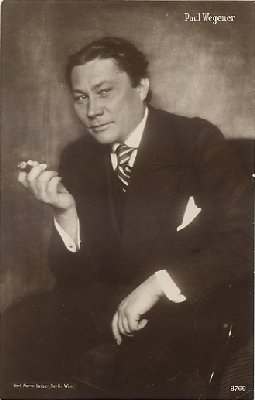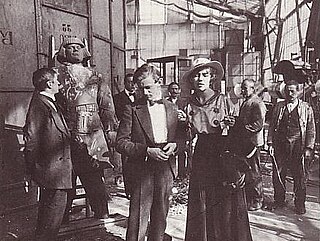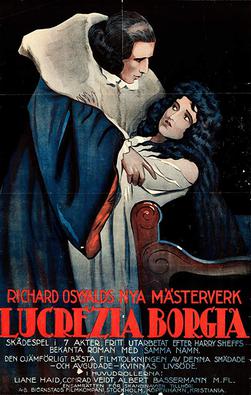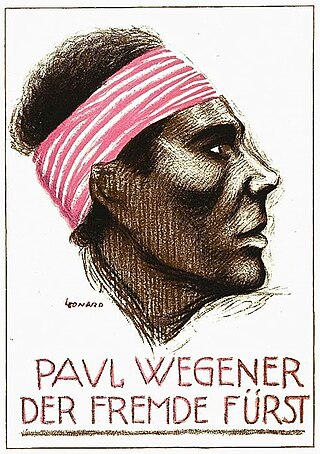
Paul Wegener was a German actor, writer, and film director known for his pioneering role in German expressionist cinema.
Der Golem is a partially lost 1915 German silent horror film written and directed by Paul Wegener and Henrik Galeen. It was inspired by a Jewish folktale, the most prevalent version of the story involving 16th century Rabbi Judah Loew ben Bezalel who created the Golem to protect his people from antisemites. Wegener claimed the film was based on Gustav Meyrink's 1915 novel The Golem, but, as the movie has little to do with existing Jewish traditions, Troy Howarth states "it is more likely that simply drew upon European folklore".
Rochus Gliese was a German actor, director, production designer, and Academy Award-nominated art director of early films from the 1910s and 1920s. He was born in Berlin.

The Golem and the Dancing Girl is a 1917 German silent comedy horror film. It is part of a trilogy, preceded by The Golem (1915) and followed by The Golem: How He Came into the World (1920). Paul Wegener and Rochus Gliese co-directed and acted in the film. Wegener also wrote the screenplay. This was the screen debut of Fritz Feld. It was produced by Deutsche Bioscop GmbH.

The Student of Prague is a 1913 German silent horror film. It is loosely based on "William Wilson", a short story by Edgar Allan Poe, the poem The December Night by Alfred de Musset, and Faust. The film was remade in 1926, under the same title The Student of Prague. Other remakes were produced in 1935 and 2004. The film stars Paul Wegener in his film debut. It is generally deemed to be the first art film in history of German movies, but the french film The Assassination of the Duke of Guise, produced in 1908, is the first art film in history.

Lyda Salmonova was a Czech stage and film actress who appeared primarily in German films. She was married to the actor Paul Wegener and appeared alongside him in a number of films.

Lucrezia Borgia is a 1922 German silent historical film directed by Richard Oswald and starring Conrad Veidt, Liane Haid, Paul Wegener, and Albert Bassermann. It was based on a novel by Harry Sheff, and portrayed the life of the Renaissance Italian aristocrat Lucrezia Borgia (1480–1519). Botho Hoefer and Robert Neppach worked as the film's art directors, designing the period sets needed. It was shot at the Tempelhof Studios in Berlin. Karl Freund was one of the cinematographers. Famed French director Abel Gance remade the film in 1935.
The Island of Tears is a 1923 German silent film directed by Lothar Mendes and starring Lya De Putti, Paul Wegener, and Lyda Salmonova.

Monna Vanna is a 1922 German silent historical film directed by Richard Eichberg and starring Lee Parry, Paul Wegener, and Hans Stürm.
Helmsman Holk is a 1920 German silent drama film directed by Rochus Gliese and Ludwig Wolff and starring Asta Nielsen and Paul Wegener.
Malaria is a 1919 German silent film directed by Rochus Gliese and starring Lyda Salmonova, Emil Kühne, and Ewald Bach.
The Lost Shadow is a 1921 German silent film directed by Rochus Gliese and starring Paul Wegener, Wilhelm Bendow and Adele Sandrock. The cinematographer was Karl Freund. The film's sets were designed by the art director Kurt Richter. It was shot at the Tempelhof Studios in Berlin. For some reason, the film was only released in the US in 1928. It is today considered a lost film.

Duke Ferrante's End is a 1922 German silent historical film directed by Paul Wegener and Rochus Gliese and starring Paul Wegener, Hans Stürm and Hugo Döblin. It was shot at the EFA Studios in Berlin. The art direction was by Walter Reimann. It premiered at the Marmorhaus in Berlin.
The Dancer Barberina is a 1920 German silent historical drama film directed by Carl Boese and starring Lyda Salmonova, Otto Gebühr, and Harry Liedtke. Part of the group of Prussian films of the Weimar and Nazi eras, it portrays the relationship between Frederick the Great and the dancer Barberina Campanini in eighteenth century Prussia. Gebühr starred as Frederick in another film on the subject, The Dancer of Sanssouci (1932).

The Pied Piper of Hamelin is a 1918 German silent drama film directed by and starring Paul Wegener and also featuring Lyda Salmonova and Wilhelm Diegelmann. It is based on the legendary story of the Pied Piper of Hamelin.

The Foreign Prince is a 1918 German silent drama film directed by and starring Paul Wegener and also featuring Lyda Salmonova and Margarete Kupfer. It is now considered to be a lost film.

Hans Trutz in the Land of Plenty is a 1917 German silent fantasy film directed by and starring Paul Wegener and also featuring Lyda Salmonova and Ernst Lubitsch. It was one of a trilogy of fairytale-inspired films made by Wegener, along with Rübezahl's Wedding and The Pied Piper of Hamelin.
Rübezahl's Wedding is a 1916 German silent fantasy drama film directed by Rochus Gliese and Paul Wegener and starring Wegener, Lyda Salmonova, and Georg Jacoby. It was the first in a trilogy of fairytale films made by Wegener also including Hans Trutz in the Land of Plenty and The Pied Piper of Hamelin.

The Galley Slave is a 1919 German silent historical adventure film directed by Rochus Gliese and Paul Wegener and starring Wegener, Lyda Salmonova, and Paul Hartmann. Inspired by several of the novels of Honoré de Balzac including Lost Illusions, it was released in two parts on separate dates during October 1919. Although Gliese was the principal credited director, the film's star Wegener also worked on its production.
The Love Nest is a 1922 German silent film directed by Rudolf Walther-Fein and starring Paul Wegener, Reinhold Schünzel, and Lyda Salmonova. It was released in two parts.











